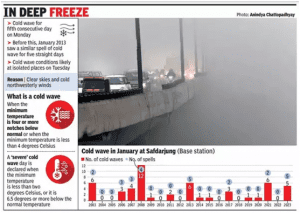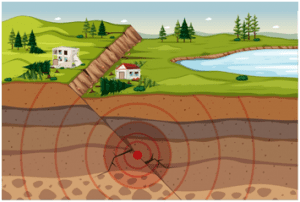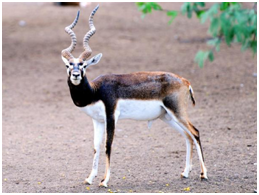TOP 5 TAKKAR NEWS OF THE DAY (11th JANUARY 2023)
1. WHAT IS A COLD WAVE?
TAGS: PRELIMS PERSPECTIVE- GS-I- GEOGRAPHY
THE CONTEXT: In the month of January 2023, Delhi and other parts of northwest India have been reeling under a cold wave.
THE EXPLANATION:
- Delhi recorded cold wave conditions for five consecutive days so far this (Jan) month, making it the longest such spell in a decade. The lowest minimum temperature recorded this month was 1.9 degrees Celsius on January 8, 2023 the second-lowest minimum temperature in January in 15 years.
- While lower-than-normal temperatures were recorded over parts of Northwest India from the December 2022 , these conditions intensified in the first week of January. Fog and low cloud coverage brought severe cold day conditions to the region, when temperatures remained below normal over parts of Delhi, Punjab, Haryana, Chandigarh, Himachal Pradesh, Rajasthan, Uttar Pradesh and Madhya Pradesh.
What is a cold wave?
- The IMD marks a cold wave in terms of minimum temperatures – when the minimum temperature in the plains is 4 degrees or less or when the minimum temperature is less than 10 degrees and 4.5 to 6.4 degrees below the normal.
- According to scientist, one of the major factors contributing to colder than normal temperatures over north India this month is the large-scale fog cover. “While westerly and north-westerly winds of around 5 to 10 kmph in the afternoon have also been contributing to the dip in temperature, an important factor this month is fog, which has been lasting for longer durations, preventing sunlight from reaching the surface and affecting the radiation balance.
- There is no heating in the day time, and then there is the impact of the night. Foggy or cloudy nights are usually associated with warmer nights, but if the fog remains for two or three days, cooling begins even at night”.

2. LAND SUBSIDENCE
TAGS: PRELIMS PERSPECTIVE- GS-I- GEOGRAPHY- GEOMORPHOLOGY
THE CONTEXT:The exact reason behind Joshimath land subsidence is still unknown but experts cite unplanned construction, over-population, obstruction of the natural flow of water, and hydel power activities as possible causes.
THE EXPLANATION:
What is Land Subsidence?
- According to the National Oceanic and Atmospheric Administration(NOAA), subsidence is the sinking of the ground because of underground material movement.
- It can happen for a host of reasons, man-made or natural, such as the removal of water, oil, or natural resources, along with mining activities. Earthquakes, soil erosion, and soil compaction are also some of the well-known causes of subsidence.
- The subsidence can happen over very large areas like whole states or provinces, or very small areas like the corner of your yard.
According to the National Oceanic and Atmospheric Administration (NOAA), subsidence is the sinking of the ground because of underground material movement.
Reasons can be manmade or natural:
- removal of water, oil, or natural resources, along with mining activities
- Earthquakes
- Soil erosion and
- Soil compaction
Reasons behind Joshimath subsidence:
- unplanned construction,
- over-population,
- obstruction of the natural flow of water and hydel power activities.
- the area is a seismic zone, which makes it prone to frequent earthquakes.
- the subsidence in Joshimath might have been triggered by the reactivation of a geographic fault —
- defined as a fracture or zone of fractures between two blocks of rock — where the Indian Plate has pushed under the Eurasian Plate along the Himalayas.
3. OZONE HOLE
TAGS: PRELIMS PERSPECTIVE- GS-III- ENVIRONMENT & ECOLOGY
THE CONTEXT: According to a new assessment says the ozone layer will recover to 1980 values by 2066 over Antarctica; in Artic by 2045. Success of Montreal Protocol is noteworthy, but phasing out greenhouse gases is more difficult.
THE EXPLANATION:
- The ozone ‘hole’, once considered to be the gravest danger to planetary life, is now expected to be completely repaired by 2066, a scientific assessment has suggested. In fact, it is only the ozone layer over Antarctica — where the hole is the most prominent — which will take a long time to heal completely. Over the rest of the world, the ozone layer is expected to be back to where it was in 1980 by 2040 itself, a UN-backed scientific panel has reported.
- The recovery of the ozone layer has been made possible by the successful elimination of some harmful industrial chemicals, together referred to as Ozone Depleting Substances or ODSs, through the implementation of the 1989 Montreal Protocol. The assessment has reported that nearly 99 per cent of the substances banned by the Montreal Protocol have now been eliminated from use, resulting in a slow but definite recovery of the ozone layer.
Damage to the ozone layer
- The depletion of the ozone layer, first noticed in the early 1980s, used to be the biggest environmental threat before climate change came along. Ozone (chemically, a molecule having three Oxygen atoms, or O3) is found mainly in the upper atmosphere, an area called stratosphere, between 10 and 50 km from the Earth’s surface. It is critical for planetary life, since it absorbs ultraviolet rays coming from the Sun.
- UV rays are known to cause skin cancer and many other diseases and deformities in plants and animals.
- Though the problem is commonly referred to as the emergence of a ‘hole’ in the ozone layer, it is actually just a reduction in concentration of the ozone molecules. Even in the normal state, ozone is present in extremely low concentrations in the stratosphere. Where the ‘layer’ is supposed to be the thickest, there are no more than a few molecules of ozone for every million air molecules.
Improvement in the situation
- The ozone hole has been steadily improving since 2000, thanks to the effective implementation of the Montreal Protocol.
- The latest scientific assessment has said that if current policies continued to be implemented, the ozone layer was expected to recover to 1980 values by 2066 over Antarctica, by 2045 over the Arctic, and by 2040 for the rest of the world.
- The elimination of ozone-depleting substances has an important climate change co-benefit as well. These substances also happen to be powerful greenhouse gases, several of them hundreds or even thousands of times more dangerous than carbon dioxide, the most abundant greenhouse gas and the main driver of global warming.
Connect the dots:
- Montreal Protocol
- Paris Agreement
- Ozone Depleting Substances or ODS’s.
4. SC DEMONETISATION VERDICT: WHAT IS DELEGATED LEGISLATION
TAGS:GS-II- POLITY
THE CONTEXT:In upholding the Centre’s 2016 decision on demonetisation, one of the key questions to decide for the Supreme Court was whether Parliament gave excessive powers to the Centre under the law to demonetise currency.
THE EXPLANATION:
While the majority ruling upheld the validity of the delegated legislation, the dissenting verdict noted that excessive delegation of power is arbitrary.
What is delegated legislation?
Parliament routinely delegates certain functions to authorities established by law since every aspect cannot be dealt with directly by the law makers themselves. This delegation of powers is noted in statutes, which are commonly referred to as delegated legislations.
- The delegated legislation would specify operational details, giving power to those executing the details. Regulations and by-laws under legislations are classic examples of delegated legislation.
- A 1973 Supreme Court ruling explains the concept as: “The practice of empowering the Executive to make subordinate legislation within a prescribed sphere has evolved out of practical necessity and pragmatic needs of a modern welfare State.
- At the same time it has to be borne in mind that our Constitution-makers have entrusted the power of legislation to the representatives of the people, so that the said power may be exercised not only in the name of the people but also by the people speaking through their representatives. The role against excessive delegation of legislative authority flows from and is a necessary postulate of the sovereignty of the people.”
What was the delegation of power in the demonetisation case?
- Section 26(2) of the Reserve Bank of India Act, 1934 essentially gives powers to the Centre to notify that a particular denomination of currency ceases to be legal tender.
- The provision reads: “On recommendation of the Central Board the Central Government may, by notification in the Gazette of India, declare that, with effect from such date as may be specified in the notification, any series of bank notes of any denomination shall cease to be legal tender.”
Why is excessive delegation power an issue?
- A 1959 landmark ruling in Hamdard Dawakhana v Union of India, the Supreme Court had struck down delegation of powers on the grounds that it was vague. A Constitution Bench considered the validity of certain provisions of the Drug and Magic Remedies (Objectionable Advertisements) Act that prohibited advertisements of certain drugs for treatment of certain diseases and dealt with the powers of search, seizure and entry.
- The Court held that the central government’s power of specifying diseases and conditions as given in Section 3(d) is ‘uncanalised’, ‘uncontrolled’, and going beyond the permissible boundaries of valid delegation. Hence, the same was deemed unconstitutional.
5. INDIAN BLACKBUCK
TAGS: PRELIMS PERSPECTIVE-ENVIRONMENT & ECOLOGY
THE CONTEXT:A new study conducted by the Indian Institute of Science (IISc) has shed light on how blackbuck in India have fared in the face of natural and human-induced challenges to their survival.
THE EXPLANATION:
- The blackbuck is found only on the Indian subcontinent. While males have corkscrew-shaped horns and black-to-dark brown coats, the females are fawn-coloured. The animals are mainly seen in three broad clusters across India that pertain to the northern, the southern, and the eastern regions.
- This geographic separation as well as dense human habitation between the clusters would be expected to make it difficult for them to move from one location to another.
Genetic profiling
- The researchers tracked the animals on foot and in vehicles from a distance to collect the samples. In the lab, they extracted and sequenced the DNA from the faecal samples to study the genetic makeup of blackbuck, and deployed computational tools to map the geographic locations with the genetic data. The team also used simulations to trace how the three present-day clusters may have evolved from their common ancestor.
- What they found was that an ancestral blackbuck population first split into two groups: the northern and the southern cluster. The eastern cluster seems to have emerged from the southern cluster.
- Next, the team found that despite all odds, male blackbuck appear to disperse more than expected, thus contributing to gene flow in this species. Females, on the other hand, appear to stay largely within their native population ranges, which the researchers inferred from unique mitochondrial signatures in each population. The data also showed an increasing trend in blackbuck population numbers as compared to the recent past.
VALUE ADDITION:
- Indian Blackbuck (Antilope cervicapra) is an antelope and is the only living species of the genus Antilope.
- It is considered to be the fastest animal in the world next to Cheetah.
- The horns of the blackbuck are ringed with one to four spiral turns and the female is usually hornless.
- Habitat:
- Blackbuck inhabits grassy plains and slightly forested areas.
- Due to its regular need of water, it prefers areas where water is perennially available.
- It is found in Central- Western India (MP, Rajasthan, Gujarat, Punjab, Haryana, Maharashtra and Odisha) and Southern India (Karnataka, Andhra Pradesh, and Tamil Nadu).
- Protection Status:
- Hunting of blackbuck is prohibited under Schedule I of the Wildlife Protection Act of 1972.
- It has been categorised least concerned in IUCN Red Data Book.
- The Bishnoi community of Rajasthan is known worldwide for their conservation efforts to blackbuck and Chinkara.